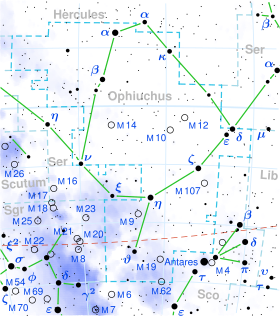| Observation data Epoch J2000 Equinox J2000 | |
|---|---|
| Constellation | Ophiuchus |
| Right ascension | 18h 07m 20.98393s[1] |
| Declination | 9° 33′ 49.8501″[1] |
| Apparent magnitude (V) | 3.73[2] + 14.0[3] |
| Characteristics | |
| Spectral type | A5 V[4] |
| U−B color index | +0.10[2] |
| B−V color index | +0.12[2] |
| Astrometry | |
| Radial velocity (Rv) | -23.90[5] km/s |
| Proper motion (μ) | RA: -62.17[1] mas/yr Dec.: +79.66[1] mas/yr |
| Parallax (π) | 37.55 ± 0.21 mas[1] |
| Distance | 86.9 ± 0.5 ly (26.6 ± 0.1 pc) |
| Absolute magnitude (MV) | 1.58[6] |
| Details | |
| Mass | 1.99[7] M☉ |
| Radius | 1.9[8] R☉ |
| Luminosity | 20[7] L☉ |
| Surface gravity (log g) | 4.04[9] cgs |
| Temperature | 8,718[9] K |
| Metallicity [Fe/H] | +0.09[6] dex |
| Rotational velocity (v sin i) | 65[7] km/s |
| Age | 250[9] Myr |
| Other designations | |
| Database references | |
| SIMBAD | data |
72 Ophiuchi is a binary star[3] system in the equatorial constellation of Ophiuchus. It is visible to the naked eye as a faint, white-hued point of light with a combined apparent visual magnitude of 3.73.[2] It is located approximately 86.9 light years away from the Sun based on parallax,[1] but is moving closer with a heliocentric radial velocity of -23.9 km/s.[5]
As of 2008, the pair had an angular separation of 25″.[3] According to Gray et al. (2003), the primary component has a stellar classification of A5 V,[4] matching an A-type main-sequence star. Cowley et al. (1969) had assigned it to a class of A4 IVs,[11] suggesting it is a sharp-lined (s) subgiant star. The latter class is still in use by some sources.[7][3][12]
The primary is 250[9] million years old with double[7] the mass of the Sun and is spinning with a moderate projected rotational velocity of 65 km/s.[7] It is radiating 20[7] times the luminosity of the Sun from its photosphere at an effective temperature of 8,718 K.[9] It displays an infrared excess, suggesting a debris disk is orbiting the star with a mean separation of 82.96 AU and temperature of 60 K.[13] The system is a source of X-ray emission,[12] which is most likely coming from the 14th[3] magnitude companion.[12]
There are additional visual companions: component C with magnitude 11.5 lies at an angular separation of 64″ from the primary,[14] while component D, has magnitude 14.8 and separation 24".[15]
This star was once considered part of the obsolete constellation Taurus Poniatovii, the brightest star in it. After the International Astronomical Union officially recognised constellations, it was placed in Ophiuchus.[16]
- ^ a b c d e f Cite error: The named reference
vanLeeuwen2007was invoked but never defined (see the help page). - ^ a b c d Cite error: The named reference
Ducati2002was invoked but never defined (see the help page). - ^ a b c d e Cite error: The named reference
Eggleton2008was invoked but never defined (see the help page). - ^ a b Cite error: The named reference
Gray2003was invoked but never defined (see the help page). - ^ a b Cite error: The named reference
Kharchenko2007was invoked but never defined (see the help page). - ^ a b Cite error: The named reference
XHIPwas invoked but never defined (see the help page). - ^ a b c d e f g Cite error: The named reference
Zorec2012was invoked but never defined (see the help page). - ^ Cite error: The named reference
AllendePrietowas invoked but never defined (see the help page). - ^ a b c d e Cite error: The named reference
David2015was invoked but never defined (see the help page). - ^ Cite error: The named reference
SIMBADwas invoked but never defined (see the help page). - ^ Cite error: The named reference
Cowley1969was invoked but never defined (see the help page). - ^ a b c Cite error: The named reference
DeRosa2011was invoked but never defined (see the help page). - ^ Cite error: The named reference
gaspar2016was invoked but never defined (see the help page). - ^ Cite error: The named reference
Rensonwas invoked but never defined (see the help page). - ^ Cite error: The named reference
WDSwas invoked but never defined (see the help page). - ^ Cite error: The named reference
ridpathwas invoked but never defined (see the help page).
